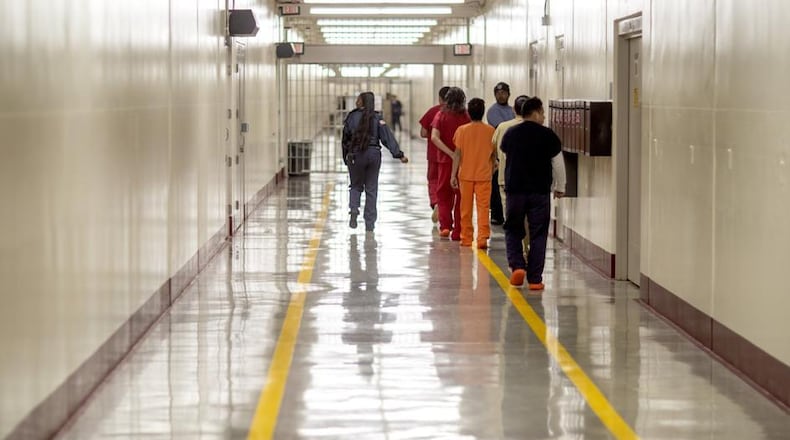About one-third of rural Wheeler County’s population is incarcerated, and nearly 30% of the people living in Calhoun County are in prison.
Despite the fact that those in prisons and detention centers across the state often aren’t from where they’re held, the government counts them as residents of those counties where the correctional facilities are located. That could put a thumb on the scale for those parts of Georgia when it comes to divvying the state into political districts.
It means inmates boost the population for counties that have prisons and give them the same or more political clout than some larger counties without prisons, even though the prisoners can’t vote if they’ve been convicted of a felony. Most of the state’s prison counties are in rural areas that are losing population.
The Prison Policy Initiative, a left-leaning nonprofit, calls it “prison gerrymandering.”
“The big problem with prison gerrymandering is it takes political representation from areas, generally areas where there are a lot of people of color, and concentrates it in generally rural areas where there are prisons, and those tend to be whiter areas,” Prison Policy Initiative spokesman Mike Wessler said. “So it concentrates political representation.”
Including the population count from prisons that are made up of mostly Black and brown inmates also skews the racial breakdown of districts and can make an area that is made up mostly of white voters appear to be racially diverse on paper, said Democratic state Rep. Winfred Dukes of Albany.
Lawmakers are in Atlanta for a once-a-decade special session dedicated to drawing new state and congressional district lines for the 10.7 million residents counted last year in the U.S. census. Georgia gained 1 million residents between 2010 and 2020, with most of them living in metro areas.
There are 11 states that attempt to reallocate prison populations to adjust the tally given by the federal government. Some states count people who are incarcerated as being at their last known address. Others don’t include them in the population when drawing district lines.
And while state officials here don’t modify population counts to account for those who are incarcerated, a few Georgia cities and counties take the numbers into consideration.
Calhoun County officials removed the number of inmates held at Calhoun State Prison when drawing district lines for the County Commission 10 years ago and plan to do the same thing this year, County Administrator Mandie Milner said.
Credit: Isaac Sabetai
Credit: Isaac Sabetai
According to the Georgia Department of Corrections, there were 1,642 inmates at Calhoun State Prison as of May 1, 2020, when the count for the U.S. census was taken. Calhoun County had a population of 5,573 last year, according to census numbers. Milner said it only made sense to remove the inmate population when drawing districts for the county.
“We have five districts in Calhoun County,” she said, “and we’re trying to make sure that we have the same amount of people in each district voting.”
In a county that small, including the 1,600 people held at Calhoun State Prison would dramatically skew the redistricting process, Milner said.
Gina Wright, executive director of the state’s Legislative and Congressional Reapportionment Office, said her office makes sure local governments are aware when a large portion of their population consists of those who are incarcerated and how that could affect district drawing. When it comes to drawing state district lines, she said, the percentage isn’t typically as significant. Each of the 180 House districts is expected to have about 60,000 residents, while Senate districts will have about 191,000 residents.
“In the grand scheme of a 60,000-person (House) district, that’s not nearly the same impact as it would be if it’s half or more of a (local) district,” Wright said.
Some lawmakers who represent rural areas with larger prison populations agree with Wright.
Two of the counties with the highest percentage of its population being incarcerated — Calhoun County with 29% and Stewart County at 25% — are in the southwest Georgia Senate district represented by state Sen. Freddie Powell Sims.
Credit: Isaac Sabetai
Credit: Isaac Sabetai
Sims, a Dawson Democrat, said regardless of whether someone is incarcerated or not, they deserve to have political representation.
“You can’t just dismiss them and pretend that they don’t exist,” she said. “They are part of the the county. They are living there as long as they are incarcerated or detained. So they have to be taken care of. And no, they’re not able to vote, but they’re still considered a part of that county. And they have needs.”
State Sen. Blake Tillery, a Vidalia Republican whose district includes Wheeler County, said while counting those who are incarcerated in the district where they’re being held may not always accurately reflect a community, it’s better than not counting them at all. Nearly 31% of Wheeler County’s 7,471 residents were being held in the Wheeler Correctional Facility.
“If a census is being mailed to their old address, and we know it’s not getting to them, we do need to make sure that they’re counted,” Tillery said. “They’re people. They’re citizens. We have to make sure they’re counted.”
New Georgia district sizes
14 congressional districts: 765,136 residents each
56 state Senate districts: 191,284 residents each
180 state House seats: 59,511 residents each
Georgia population: 10,711,908
Source: House Budget and Research Office
About the Author
Keep Reading
The Latest
Featured






